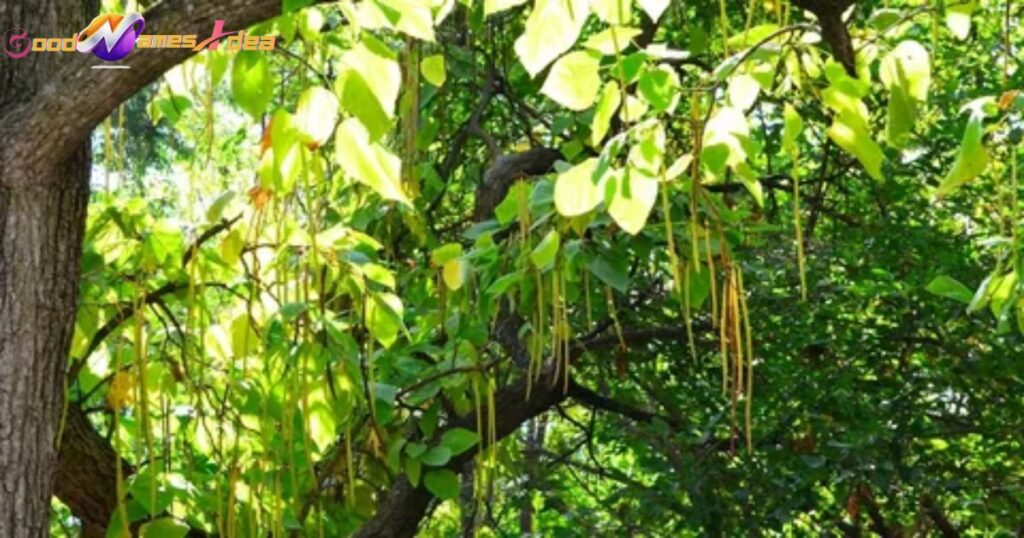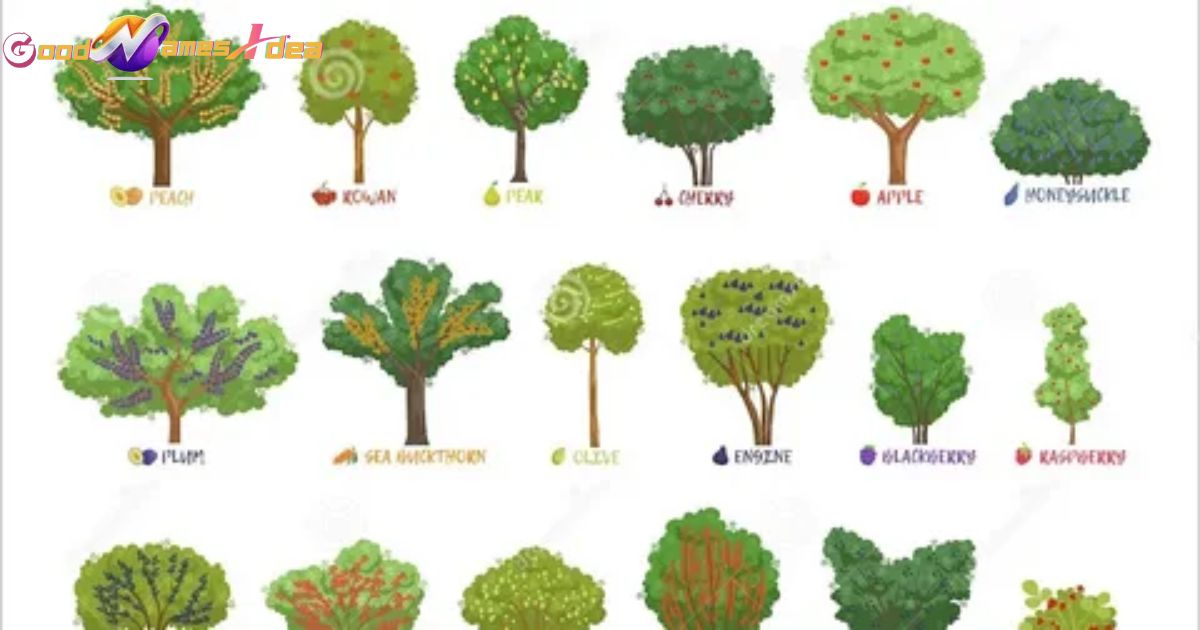We are talking about every famous tree. Whether it’s the labels we give to trees. You know, like oak, maple and pine? They are not just random words, but specific identifiers that help us tell one type of tree from another. So, the next time you’re strolling through a forest or admiring a tree-lined street, pay attention to the names of these trees. They hold the key to unlocking the beauty and diversity of our leafy friends.
Unique Tree Names
These are all unique names
| Baobab | Pine | Maple | Rowan |
| Willow | Cypress | Magnolia | Aspen |
| Sycamore | Juniper | Birch | Hawthorn |
| Yew | Alder | Cedar | Ginkgo |
| Dogwood | Redwood | Ebony | Hazel |
| Linden | Olive | Poplar | Mahogany |
| Spruce | Cherry | Beech | Sequoia |
| Elm | Palm | ||
Botanical Tree Names
Here are the names of botanical trees

| Scientific Name | Common Name |
| Quercus | Oak |
| Acer | Maple |
| Pinus | Pine |
| Betula | Birch |
| Fagus | Beech |
| Ulmus | Elm |
| Populus | Poplar |
| Juniperus | Juniper |
| Cedrus | Cedar |
| Salix | Willow |
| Platanus | Sycamore |
| Taxus | Yew |
| Fraxinus | Ash |
| Picea | Spruce |
| Alnus | Alder |
| Juglans | Walnut |
| Corylus | Hazel |
| Carya | Hickory |
| Ginkgo | Ginkgo Biloba |
| Sequoia | Sequoia |
| Quercus suber | Cork Oak |
| Prunus | Cherry |
| Tilia | Linden |
| Carpinus | Hornbeam |
| Olea | Olive |
| Morus | Mulberry |
| Diospyros | Ebony |
| Castanea | Chestnut |
| Citrus | Citrus tree |
Metasequoia (Dawn Redwood)
These botanical tree names represent a variety of tree species, each with its own scientific classification and characteristics. Exploring these names can deepen our understanding of the botanical world and the diversity of trees.
Yellow Tree Names

| Common Name | Scientific Name |
| Golden Rain Tree | Koelreuteria paniculata |
| Osage Orange | Maclura pomifera |
| Yellowwood | Cladrastis kentukea |
| Honeylocust | Gleditsia triacanthos |
| Yellow Birch | Betula alleghaniensis |
| Yellow Buckeye | Aesculus flava |
| Yellow Poplar | Liriodendron tulipifera |
| Yellow Magnolia | Magnolia acuminata |
| Yellow Elder | Tecoma stans |
| Yellow-Flowered Acacia | Acacia longifolia |
Each common name is paired with its corresponding scientific name in the table.
Green Tree Names
| Common Name | Scientific Name |
| Emerald Ash | Fraxinus pennsylvanica |
| Green Ash | Fraxinus pennsylvanica |
| Green Maple | Acer rubrum |
| Green Beech | Fagus sylvatica |
| Green Giant Arborvitae | Thuja plicata ‘Green Giant’ |
| Green Alder | Alnus viridis |
| Green Willow | Salix purpurea |
| Green Spruce | Picea glauca |
| Green Oak | Quercus spp. |
| Green Pine | Pinus spp. |
These tree names represent different species that often have green foliage as their characteristic color. Green trees contribute to the beauty and vitality of landscapes, providing shade, oxygen, and a refreshing aesthetic appeal to their surroundings.
Types of Trees
Here are some Types
Deciduous Trees: Deciduous trees are known for their seasonal foliage changes. They shed their leaves during the fall, showcasing vibrant colors before entering a period of dormancy. Examples of deciduous trees include oaks, maples, birches, and beeches.
Coniferous Trees: Coniferous trees, also known as evergreens, maintain their green foliage throughout the year. They typically have needle-like or scale-like leaves and produce cones to disperse their seeds. Well-known coniferous trees include pines, spruces, firs, and cedars.
Flowering Trees: Flowering trees add a burst of color and fragrance to the landscape. These trees produce beautiful blossoms in various hues and attract pollinators such as bees, butterflies, and birds. Cherry blossoms, magnolias, dogwoods, and jacarandas are popular examples of flowering trees.
Fruit Trees: Fruit trees bear edible fruits and are cultivated for their delicious bounty. These trees not only provide nourishment but also enhance the aesthetics of gardens and orchards. Apple trees, orange trees, peach trees, and lemon trees are just a few examples of fruit-bearing trees.
Shade Trees: Shade trees are valued for their ability to provide relief from the scorching sun. These trees have broad, spreading canopies that create cool and shaded areas beneath them. Species like oak, maple, and sycamore are well-known for their shade-providing qualities.
Ornamental Trees: Ornamental trees are cultivated for their visual appeal and are often chosen for their unique foliage, bark patterns, or overall form. They are commonly used in landscaping to add beauty and interest to gardens and parks. Japanese maple, crape myrtle, flowering dogwood, and redbud are popular choices for ornamental trees.
Indigenous Trees: Indigenous trees are native to specific regions or ecosystems and play a vital role in maintaining local biodiversity. These trees are well-adapted to the local climate, soil conditions, and wildlife interactions. Planting indigenous trees helps preserve the natural heritage of an area and supports local ecosystems.
Tropical Trees: Tropical trees thrive in warm and humid climates, often found in tropical rainforests and other tropical regions. They exhibit lush foliage, diverse forms, and provide habitats for countless animal species. Examples of tropical trees include palms, teak, mahogany, and kapok trees.
Coastal Trees: Coastal trees are specially adapted to withstand the challenging conditions of coastal areas, such as strong winds, salt spray, and sandy soils. These trees help stabilize coastal ecosystems and provide protection from erosion. Coastal species like mangroves, sea grapes, and beach pines are well-suited to such environments.
Bonsai Trees: Bonsai trees are not a specific type of tree but rather a horticultural practice of growing trees in miniature form. These meticulously trained and pruned trees create captivating living artworks, showcasing the beauty of nature in a small-scale setting.
A to Z Tree Names
Alder, Almond, Apple, Ash
Balsa, Beech, Birch, Blackthorn,
Cedar, Cherry, Chestnut, Cypress
Daisy tree, Date palm, Douglas fir, Dogwood,
Elder, Elm, Eucalyptus
Fiddlewood, Fig, Fir
Ginkgo, Grapefruit, Gum tree
Hawthorn, Hazel, Hemlock, Hickory,
Indian almond, Indian laurel, Ironwood, Ivory palm
Jacaranda, Jacoba, Jasmine, Juniper
Kapok, Kapok tree, Kauri, Koala-scented gum
Larch, Lemon, Lemon-scented gum, Linden
Magnolia, Mango, Maple, Mulberry,
Niaouli, Nutmeg, Nootka cypress
Oak, Olive, Orange
Palm, Papaya, Peach, Pine, Poplar,
Quaking aspen, Quandong, Queen palm, Quince
Rain tree, Red horse chestnut, Redwood, Rosewood
Sequoia, Silver birch, Spruce, Sycamore
Tamarind, Teak, Tulip tree, Tulip tree,
Uva ursi, Umbrella tree, Umbrella Thorn Acacia, Umbrella magnolia
Valley oak, Vanilla, Viburnum, Vine maple
Walnut, White ash, White poplar, Willow
Xanthorrhoea, Xanthostemon, Xylocarpus, Xylosma
Yellow birch, Yellowwood, Yellowwood, Yew
Zebrawood, Zelkova, Ziziphus, Zigzag willow
These tree names cover a wide range of species and represent various regions and characteristics. Enjoy exploring the diverse world of trees.
Frequently Asked Questions
What is the scientific name of a tree?
Scientific names follow binomial nomenclature, consisting of a capitalized genus name followed by a lowercase species name, like Quercus robur for the oak tree.
How do trees get their common names?
Common names vary by region and language, often derived from tree characteristics, appearance, uses, or historical significance, resulting in regional variations.
Are tree names universal?
Tree names can be global, but many common names are region-specific, leading to variations across different places and communities.
Can tree names change over time?
Yes, tree names can change due to taxonomic revisions, scientific advancements, or the discovery of new species, affecting both scientific and common names.
Conclusion
Tree names weave a beautiful tapestry of nature’s wonders. From the mighty oak to the graceful willow, each name carries a story of resilience and beauty. Exploring their rich diversity connects us to the natural world.
The language of trees is a testament to our deep-rooted relationship with nature. As we encounter the majestic sycamore or the delicate cherry blossom, their names evoke images of strength and fragility. Through these names, we honor the intricate interplay between our lives and the trees that breathe life into our surroundings.











